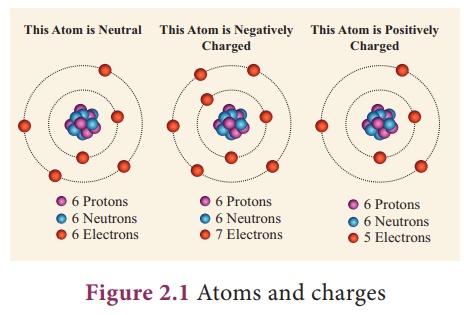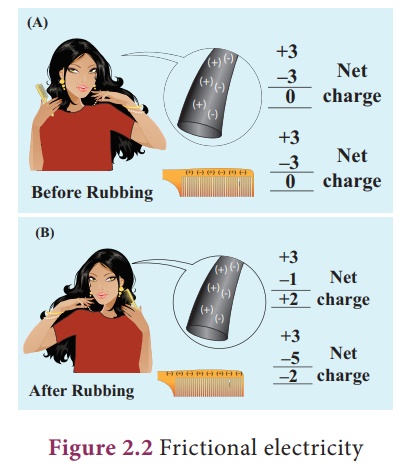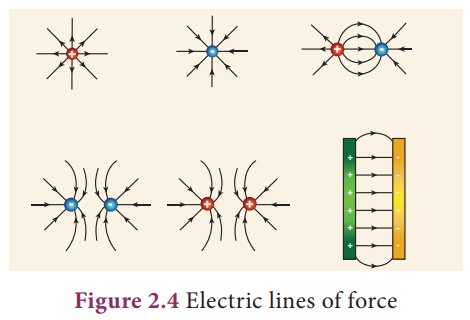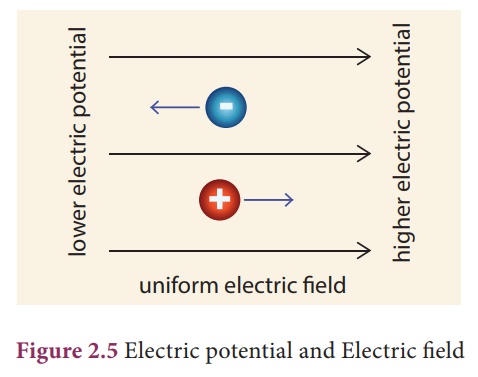Chapter: 9th Science : Electric charge and electric current
Electric charges
Electric charges
We know that all matter
is made up of tiny particles called, atoms. Inside each atom there is a nucleus
with positively charged protons and chargeless neutrons and negatively charged
electrons orbiting the nucleus. Usually there are as many electrons as there
are protons and the atoms themselves are neutral.
As electrons are
revolving in the orbits of an atom, they can be easily removed from an atom and
also added to it. If an electron is removed from the atom, the atom becomes
positively charged. Then it becomes a positive ion. If an electron is added in
excess to an atom then the atom is negatively charged. This atom is called
negative ion. More than one electron can also be removed from or added to atoms
to make them accordingly more positive and more negative (Fig. 2.1).

When you rub a plastic
comb on your dry hair, the comb obtains power to attract small pieces of paper,
is it not? When you rub the comb vigorously, electrons from your hair leave and
accumulate on the edge of the comb. Your hair is now positively charged as it
has lost electrons. The comb is negatively charged as it has gained electrons
(Fig. 2.2).

1. Measuring electric charge
Electric charge is
measured in coulomb and the symbol for the same is C. The charge of an electron
is numerically a very tiny value. The charge of an electron (represented as e) is
the fundamental unit with a charge equal to 1.6 x 10-19 C. This
indicates that any charge
(q) has to be an integral multiple (n) of this
fundamental unit of electron charge (e).
q = ne
here, n is a whole
number.
Can you guess how many
electrons accumulate to make 1 C of electric charge?
Exercise 2.1
How many electrons will be there in one coulomb of charge?
Solution:
Charge on 1 electron, e
= 1.6 x 10–19 C
q=ne or n=q/e
number of electrons in 1
coulomb

= 6.25 x 1018
electrons
Practically, we also
have µC (micro coulomb) nC (nano coulomb)and pC (pico coulomb) as units of
electric charge.
1 µC = 10-6
C, 1nC=10-9 and 1pC = 10-12C
Electric charge is additive in nature. e total electric charge of a system is the algebraic sum of all the charges located in the system. For example, let us say a system has two charges +5C and –2C. en the total or net charge on the system is, (+5C) + (–2C) = +3C.
2. Electric force
Among electric charges
there are two types of electric force (F). One is attractive and another is
repulsive. The like charges repel and unlike charges attract. The force existing between the
charges is called as ‘electric force’. These forces are non-contact forces, and hence can be
experienced even when the charges are not in contact.

The numerical value (magnitude) of
electric force between two charges depend on the,
i.
value
of charges on them,
ii.
distance
between them and
iii.
nature
of medium between them.
3. Electric field
The region in which a
charge experiences electric force forms the ‘electric field’ around the charge.
O en electric field (E) is represented by lines and arrowheads indicating the
direction of the electric led (Fig. 2.4). The direction of the electric field
is the direction of the force that would act on a small positive charge.
erefore the lines representing the electric field are called ‘electric lines of
force’. The electric lines of force are straight or curved paths along which a
unit positive charge tends to move in the electric field. Electric lines of force
are imaginary lines. The strength of an electric field is represented by how close the
field lines are to one another.
For an isolated positive
charge the electric lines of force are radially outwards and for an isolated
negative charge they are radially inwards.

Electric field at a
point is a measure of force acting on a unit positive charge placed at that
point. A positive charge will experience force in the direction of electric
field and a negative charge will experience in the opposite direction of
electric field.
4. Electric potential
Though there is an
electric force (either attractive or repulsive) existing among the charges,
they are still kept together, is it not?. We now know that in the region of
electric charge there is an electric field. Other charges experience force in
this field and vice versa. ere is a work done on the charges to keep them
together. is results in a quantity called ‘electric potential’.

Electric potential is
a measure of the work done on unit positive charge to bring it to that point
against all electrical forces. The electric potential (V) near
positive charges is positive and near a negative charges is negative. Other
positive charges have a tendency to move from higher potential to lower
potential and negative charges the other way.
Related Topics